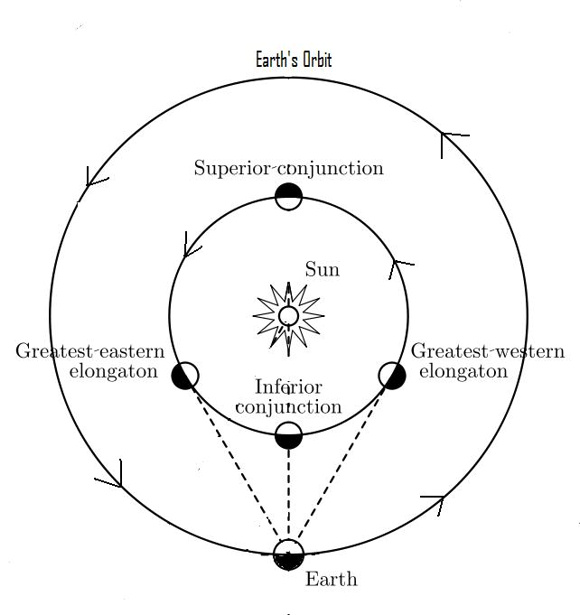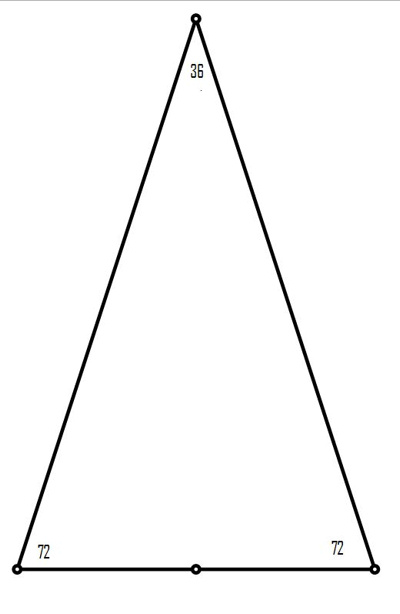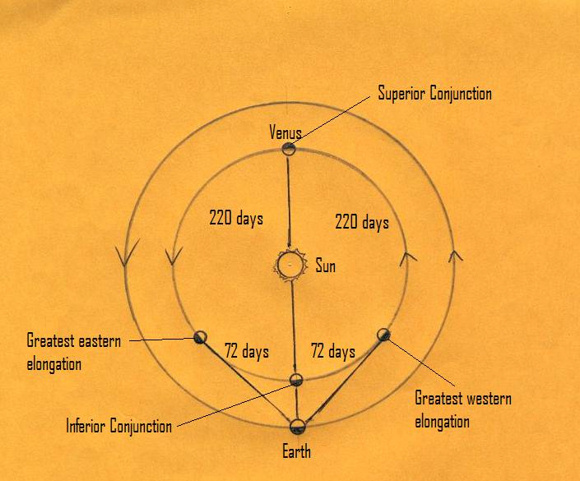Two major celestial events will happen almost concurrently in the predawn sky this month. The Perseid meteor shower will reach its annual peak on the mornings of August 11, 12 and 13. And the brightest planet, Venus, will swing out to its greatest elongation, or greatest apparent distance from the sun in our sky, in the east before sunup on August 12 or 13 (August 13 at 00:00 UTC. Translate UTC to your time.)
The Perseids are rising to their peak now. And Venus is already high and bright in the east at dawn. So – in the hours before sunup in the coming mornings, and especially around August 11, 12 and 13 – you can simultaneously be watching for Perseid meteors, and witness Venus at its most glorious.
The Perseid meteor shower is an annual event, its peak coming on or near the same date every year. Meanwhile, Venus has a regular 8-year cycle in our sky. Thus we won’t have a greatest morning elongation of Venus so closely coinciding with the peak of a Perseid meteor shower again until August 2028.
Now the bad news. This year’s Perseid peak will be somewhat obscured by moonlight. The moon reaches its last quarter phase on August 11. A last quarter moon rises at midnight, and, like most meteors in annual showers, the Perseids don’t kick into high gear each night until midnight or afterwards, when the shower’s radiant point has had a chance to ascend in your sky. Don’t let the moon discourage you, though. Perseid meteors tend to be bright. Some will overcome the moon’s glare. This post tells you how to minimize the moon and optimize your chances for seeing the most possible meteors in 2020.
Read more: Peak Perseid mornings: August 11, 12, 13
Read more: The 8-year cycle and 5 petals of Venus

What causes a greatest morning elongation of Venus?
Because Venus orbits the sun inside our planet’s orbit, Venus appears rather closely tethered to the sun, as seen from Earth.
For instance, Venus can never be opposite (180 degrees from) the sun in our sky (like the full moon), or even be as far as 90 degrees from the sun (like a half-lit quarter moon).
At the end of its tether – at the outer edge of its orbit as seen from Earth – Venus, at most, swings a little over 47 degrees from the sun on the sky’s dome. That maximum distance is what astronomers call a greatest elongation. If, at such a time, Venus is shining east of the sun, we see Venus in the west after sunset. If Venus is shining west of the sun, we see Venus in the east before sunrise.
On August 12 or 13, 2020 (depending on your time zone) Venus swings 45.8 degrees west of the sun, exhibiting its greatest elongation in the morning sky.

The Golden Triangle and Venus’ cycles
Once you become conversant with the Golden Triangle, you automatically possess the Rosetta Stone to Venus and her golden cycles. The Golden Triangle is an isosceles triangle with two of its angles = 72 degrees and the third angle = 36 degrees.
These two numbers, 72 and 36, give you the means to master Venusian cycles.
Look at the illustration below to see Venus’ orbit inside Earth’s orbit. We’re viewing the north side of the solar system plane, whereby the planets revolve counterclockwise around the sun. Venus is at its greatest eastern (evening) elongation at left and its greatest western (morning) elongation at right.
A greatest western (morning) elongation of Venus takes place some 144 days after Venus’ greatest eastern (evening) elongation.
Thus, about 72 days after reaching its greatest eastern elongation in the evening sky, Venus passes between the sun and Earth at inferior conjunction. Then 72 days after reaching inferior conjunction, Venus swings out to its greatest western elongation in the morning sky.
So, to remember Venus’ cycles, remember the Golden Triangle and the number 72!


Look through the telescope, and you’ll see that Venus’ disk always displays a half-lit (50% illuminated) quarter phase at the vicinity of its greatest elongation, either in the evening or morning sky. It’s a waning quarter Venus in the evening sky and a waxing quarter Venus in the morning sky.
At its greatest elongation, Venus makes a right (90 degree) angle with the Earth and sun, with Venus residing at the vertex of this 90-degree angle. The innovative astronomer Copernicus used a greatest elongation and trigonometry to figure out that Venus’ distance from the sun equals 0.72 the Earth’s distance from the Sun. Uncanny how that number 72 keeps cropping up!
Don’t forget the number 36!
This may come as a surprise to you, but Venus shines at greatest brilliancy in the evening and morning sky when its disk is approximately one-quarter (25%) illuminated by sunshine. Midway between a greatest elongation and an inferior conjunction, Venus showcases its greatest illuminated extent, at which juncture the illuminated portion of Venus covers the greatest square area of sky. Venus reaches its greatest illuminated extent some 36 days before and after inferior conjunction. It also reaches its greatest illuminated extent some 36 days after its greatest evening elongation, and 36 days before its greatest morning elongation.
Venus and the Pentagram
Venus is often represented by the Pentagram, which is composed of 5 Golden Triangles and a regular pentagon. The Pentagram well symbolizes Venus because all Venus’ milestones (greatest evening elongation, greatest illuminated extent in the evening sky, inferior conjunction, greatest illuminated extent in the morning sky, greatest morning elongation and superior conjunction) recur five times in eight Earth-years or 13 Venus-years. Some of you may recognize the 5:8:13 Fibonacci sequence, a tribute to the beauty of Venus and the Golden Ratio!

Bottom line: In 2020, the peak of the Perseid meteor shower nearly coincides with Venus’ greatest elongation, or greatest apparent distance from the sun in our sky. Both will fall around the mornings of August 11, 12 and 13.











